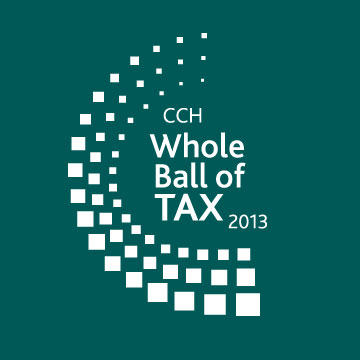| Home | About Us | Order Products | Press Center | Customer Service | Career Opportunities |

CCH can assist you with stories, including interviews with CCH subject experts.
Also, the 2013 Visit the CCH Whole Ball of Tax site often as new releases and other updates will be posted CCH provides special CCH Tax Briefings on key topics at CCHGroup.com/Legislation.
|
CCH Says Permanent AMT Relief Addresses Tax Season Uncertainty(RIVERWOODS, ILL., January 2013) – When Congress and the White House finally forged an agreement to avoid the “fiscal cliff,” more than 25 million taxpayers who would have been impacted by an automatic return to previous alternative minimum tax (AMT) levels breathed a huge sigh of relief. The new American Taxpayer Relief Act of 2012 (ATRA) offers permanent AMT relief by “patching” the AMT for 2012 and subsequent years. CCH, a Wolters Kluwer business and a leading global provider of tax, accounting and audit information, software and services (CCHGroup.com), takes an in-depth look at the AMT and how new legislation affects taxpayers. What’s New?With the ATRA’s passage, AMT exemption amounts were increased along with an annual inflation adjustment to the exemption amounts for years beginning after 2012. The new 2012 tax season exemption amounts are: $50,600 for unmarried taxpayers; $78,750 for married taxpayers filing jointly and surviving spouses; and $39,375 for married taxpayers filing separately. The ATRA also provides that all nonrefundable personal credits are allowed to the full extent of a taxpayer’s regular tax and AMT liability, effective for tax years beginning after 2011. Had AMT exemption amounts not been adjusted, they would have automatically fallen back to the previous levels of $33,750 for single taxpayers, $45,000 for married taxpayers filing a joint tax return and $22,500 for married taxpayers filing separately – affecting many more people. “The top AMT tax bracket is 28 percent while the top regular tax bracket is 39.6 percent. So wealthier people tend to be less often subject to the AMT than other taxpayers, even when they are able to claim more deductions,” said CCH Principal Federal Tax Analyst Mark Luscombe, JD, LLM, CPA. “In fact, taxpayers most likely to be caught by the AMT are those earning $500,000 to $1 million.” What Is the AMT?The AMT is an alternate way of figuring income tax with its own tax rates and its own set of rules, including those limiting credits and deductions traditionally available under the rest of the “regular” tax code. Generally, taxpayers may be subject to the AMT if their taxable income for regular tax purposes plus any adjustments and tax preference items results in an amount higher than the AMT exemption amount. If the AMT applies, they must separately figure a second tax by eliminating many deductions and credits. The taxpayer then must pay whichever is higher – the regular tax or the AMT. Why Is There an AMT?The original idea of the AMT, when enacted in 1969, was to make certain that wealthy taxpayers were not using tax loopholes or taking excessive tax breaks. However, the AMT has changed little in 43 years. Because the AMT was never indexed for inflation, and for other reasons, the AMT today encroaches on many moderate-income taxpayers, especially two-income married couples. It’s a good idea to consult a tax professional to explore whether certain deductions will or won’t trigger the AMT. How It WorksCalculating whether they are subject to the AMT requires taxpayers to figure out their regular federal tax, then calculate the AMT and pay whichever is greater. Many items can trigger an AMT liability and some tax breaks allowed when calculating regular taxes change or disappear when applied to AMT. Items disappearing include the standard deduction and personal exemptions. Additionally, many itemized deductions, which often favor higher income individuals, are not allowed in calculating the AMT. For example, the itemized deduction for state taxes can’t be subtracted from income in figuring AMT. As a result, residents of high-tax states – such as New York or California – are more likely to find themselves subject to the tax. Also, miscellaneous itemized deductions aren’t allowed in figuring the AMT, either. This can affect taxpayers with large amounts of unreimbursed business expenses. Special rules apply for certain other itemized deductions, including medical expenses, home mortgage interest and investment interest deductions in calculating the AMT. For example, an itemized deduction for the interest on a mortgage that pays for the taxpayer’s home or for home improvements is deducted for both regular tax purposes and the AMT, but if the taxpayer borrowed against their home to buy something else or pay down their credit card balance, the interest is not deductible on the AMT form. For detail on itemized deductions see Release 24. AMT TriggersNo single item alone may trigger the AMT. However, among those contributing to it could be:
“People need to look at their own situation,” Luscombe cautioned. “A taxpayer with a large family and high medical costs earning $75,000 may find they are subject to the AMT as a result of having a large number of itemized deductions and a large number of personal exemptions.” A worksheet in the instructions for Form 1040, and its electronic equivalent, the “AMT Assistant” on the IRS web site (IRS.gov), tells taxpayers whether they might be subject to the AMT. How the Type of Taxpayer Affected By the AMT Has ChangedRegular tax rules index various items, such as tax brackets, the standard deduction and personal exemptions. The AMT in the past has not. Under the AMT, taxpayers pay a tax rate of 26 percent on the first $175,000 of alternative minimum taxable income ($87,500 for married couples filing separately) and 28 percent over those amounts, in excess of an exemption amount. With new rules outlined in the new ATRA, there will still not be inflation adjustments in the AMT rate brackets, but there is now a permanent adjustment in the exemption amount moving forward. Previously, the AMT exemption amount had only been adjusted for inflation on a temporary basis. Additionally, the series of tax reductions that started in 2001 actually expose more people to the AMT, precisely because they lower regular taxes. People have been able to reduce their taxable income under regular taxes, which for some has exposed them to the AMT. As a result, lowering taxes without addressing the AMT can actually result in higher taxes for a greater segment of middle-income taxpayers. Will the AMT Be Abolished?With the potential for comprehensive tax reform negotiations in Congress later this year, the future of the AMT could be decided – which could include it being abolished. However, even though fewer taxpayers are impacted with new exemption levels, the AMT still raises much needed revenue. For example, the two-year extension through 2011 of the AMT patch cost the government an estimated $136.7 billion in lost revenue. About CCH, a Wolters Kluwer businessCCH, a Wolters Kluwer business (CCHGroup.com) is a leading global provider of tax, accounting and audit information, software and services. Celebrating its 100th anniversary in 2013, CCH has served tax, accounting and business professionals since 1913. Among its market-leading solutions are the ProSystem fx® Suite, CCH Integrator™, CCH® IntelliConnect®, Accounting Research Manager® and the U.S. Master Tax Guide®. CCH is based in Riverwoods, Ill. Follow us on Twitter @CCHMediaHelp. Wolters Kluwer (www.wolterskluwer.com) is a market-leading global information services company. Wolters Kluwer is headquartered in Alphen aan den Rijn, the Netherlands. Its shares are quoted on Euronext Amsterdam (WKL) and are included in the AEX and Euronext 100 indices. --###-- nb-13-21
|
© 2024, CCH INCORPORATED. All rights reserved. |
Back to Top | Print this Page | ||||||||||||||||||
